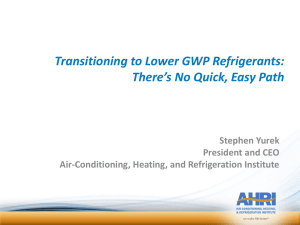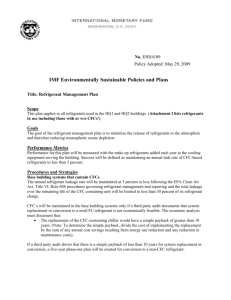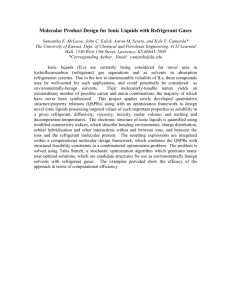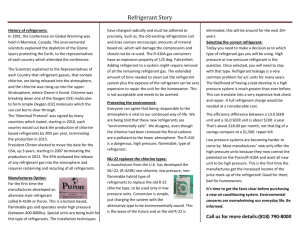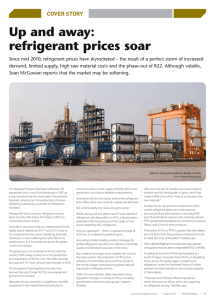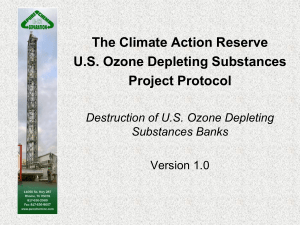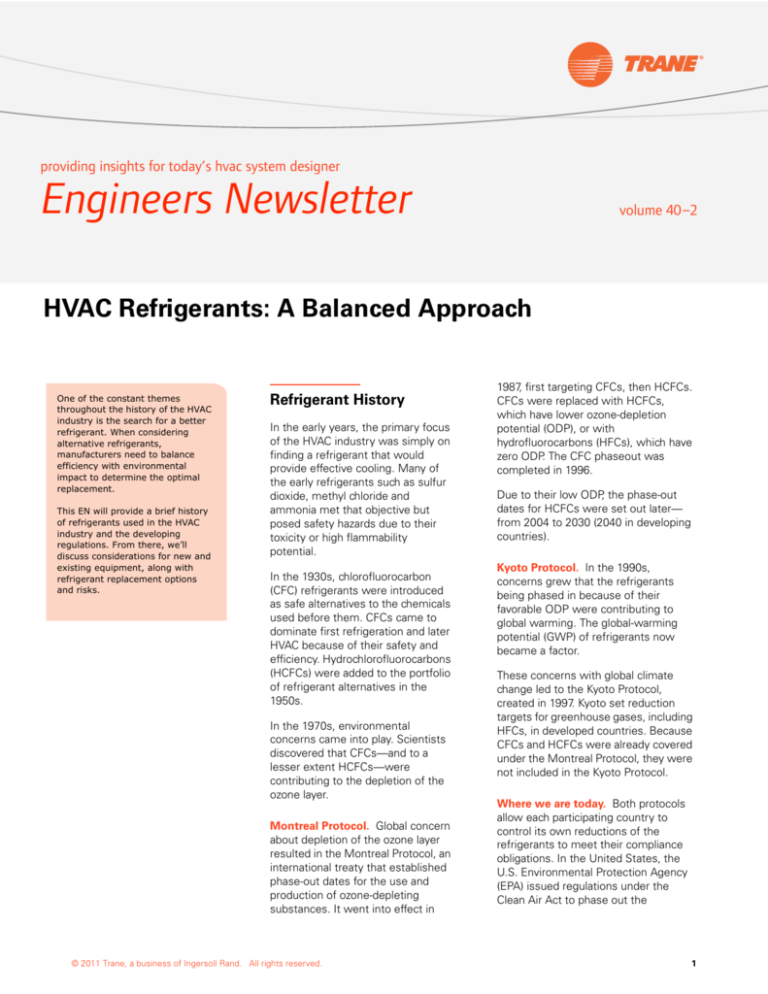
providing insights for today’s hvac system designer
Engineers Newsletter
volume 40 –2
HVAC Refrigerants: A Balanced Approach
One of the constant themes
throughout the history of the HVAC
industry is the search for a better
refrigerant. When considering
alternative refrigerants,
manufacturers need to balance
efficiency with environmental
impact to determine the optimal
replacement.
This EN will provide a brief history
of refrigerants used in the HVAC
industry and the developing
regulations. From there, we’ll
discuss considerations for new and
existing equipment, along with
refrigerant replacement options
and risks.
Refrigerant History
In the early years, the primary focus
of the HVAC industry was simply on
finding a refrigerant that would
provide effective cooling. Many of
the early refrigerants such as sulfur
dioxide, methyl chloride and
ammonia met that objective but
posed safety hazards due to their
toxicity or high flammability
potential.
In the 1930s, chlorofluorocarbon
(CFC) refrigerants were introduced
as safe alternatives to the chemicals
used before them. CFCs came to
dominate first refrigeration and later
HVAC because of their safety and
efficiency. Hydrochlorofluorocarbons
(HCFCs) were added to the portfolio
of refrigerant alternatives in the
1950s.
In the 1970s, environmental
concerns came into play. Scientists
discovered that CFCs—and to a
lesser extent HCFCs—were
contributing to the depletion of the
ozone layer.
Montreal Protocol. Global concern
about depletion of the ozone layer
resulted in the Montreal Protocol, an
international treaty that established
phase-out dates for the use and
production of ozone-depleting
substances. It went into effect in
© 2011 Trane, a business of Ingersoll Rand. All rights reserved.
1987, first targeting CFCs, then HCFCs.
CFCs were replaced with HCFCs,
which have lower ozone-depletion
potential (ODP), or with
hydrofluorocarbons (HFCs), which have
zero ODP. The CFC phaseout was
completed in 1996.
Due to their low ODP, the phase-out
dates for HCFCs were set out later—
from 2004 to 2030 (2040 in developing
countries).
Kyoto Protocol. In the 1990s,
concerns grew that the refrigerants
being phased in because of their
favorable ODP were contributing to
global warming. The global-warming
potential (GWP) of refrigerants now
became a factor.
These concerns with global climate
change led to the Kyoto Protocol,
created in 1997. Kyoto set reduction
targets for greenhouse gases, including
HFCs, in developed countries. Because
CFCs and HCFCs were already covered
under the Montreal Protocol, they were
not included in the Kyoto Protocol.
Where we are today. Both protocols
allow each participating country to
control its own reductions of the
refrigerants to meet their compliance
obligations. In the United States, the
U.S. Environmental Protection Agency
(EPA) issued regulations under the
Clean Air Act to phase out the
1
production and import of CFCs and
HCFCs.
Figure 1. Legislative actions involving refrigerant
Montreal Protocol signed
Figure 1 provides a summary of the
major actions involving refrigerants in
developed and developing countries.
The dates on the chart are for the
United States and Canada (dates in
other countries vary).
The Montreal and Kyoto protocols have
set dates to ensure long-term
availability. When production of a
refrigerant stops, the time lines allow
for the recycled, recovered and
stockpiled supplies to continue to be
used without restriction. For example,
production of CFCs ended in 1996, but
inventory of these refrigerants is still
readily available.
What’s ahead. Policy pressure
impacting nearly all commercially viable
refrigerants available today has
accelerated the development of
alternatives.The next family of
refrigerants, known as
hydrofluoroolefins (HFOs), have
properties similar to HCFCs and HFCs
but with minimal direct environmental
impact. The first HFO on the market
has been developed to replace R-134a
for automotive applications and will
begin implementation this year in
Europe. Implementation of HFOs will
lag in the HVAC industry as
manufacturers develop and test new
alternatives, and global regulators
decide on a future path.
A Balanced Approach
When considering refrigerant
alternatives for the future, policy
makers, the public, and manufacturers
must balance direct environmental
concerns (ODP, GWP, leak rates),
indirect environmental concerns
(energy efficiency), safety and
performance.
Direct versus indirect impact. The
direct environmental impact of an HVAC
system is dependent on the ODP and
GWP of the refrigerant and the rate of
refrigerant leakage into the
environment.
2
Trane Engineers Newsletter volume 40–2
All CFC production
stopped (R -11,R-12) in
developed countries
1990
2000
Kyoto Protocol went
into effect
No new R-22 for service in US, Canada
No new equipment with R -123 in
developed countries
No new R-123 for service
in developed countries, no
HCFCs in new equipment
in developing countries
No CFCs for
developing
countries
2010
2020
2030
No R-134a use in new model
automobiles in Europe
Today
No HCFC production in
developing countries
2040
2050
continued use of recycled R-22,
R-123 for developing countries
continued use of recycled R-123
No new equipment
with R-22 in US, Canada
continued use of recycled R-22
continued use of recycled CFCs
Note: Included in the use of “recycled” refrigerants is also the use of stockpiled supplies of the refrigerant produced
before the phase-out date. In addition, there is no restriction on the importation of recycled and recovered supplies of
refrigerant.
While leakage rates can vary widely
among different HVAC products, good
design and servicing can keep leakage
to a minimum. (See the sidebar on p. 4.)
Years ago, when chillers used CFCs and
service practices were less concerned
with minimizing emissions, leak rates
were 2½ to 10 times what they are
today. Due to advances in technology
and the use of refrigerants with
significantly lower GWP, the direct
environmental impact from HVAC
equipment is now from 20 to 600 times
lower than the older CFC chiller designs.
These reduced leak rates, coupled with
newer refrigerants, bring the direct
global warming impact to under 5
percent of the application’s total global
warming impact.
For hermetic systems, up to 95 percent
of the total environmental impact is the
indirect impact—the energy used to
power HVAC systems. According to the
U.S. Department of Energy, 83 percent
of the primary power consumed in the
U.S. is generated by the burning of fossil
fuels, which emits greenhouse gases.
When considering both the direct and
indirect environmental impact, HCFCs
and HFCs, because of their high energy
efficiency, can be the most
environmentally responsible and
appropriate refrigerants available today
for many HVAC applications.
Evaluating alternatives. Let’s take a
look at the refrigerants that are currently
available, taking into consideration their
efficiency, direct and indirect
environmental impact, and safety.
Figure 2 compares the ODP, GWP and
energy efficiency of today’s commercial
refrigerants and potential future
refrigerants. While there is no perfect
refrigerant, the chart shows that
HCFC-123 (R-123), HFC-152a (R-152a)
and HFC-32 (R-32) strike a good balance
between ODP, GWP and efficiency.
However, the use of R-152a and R-32 is
limited because of flammability.
Refrigerants such as CO2, hydrocarbons
and ammonia have zero ODP and a very
low GWP. Let’s take a closer look.
providing insights for today’s HVAC system designer
Carbon dioxide. CO2 has potential as
a low-temperature refrigerant in
refrigeration applications. However, it
has very low efficiency in HVAC
applications, more than 20 percent
below the efficiency of R-22 and
R-410A, due to operation above the
critical point of CO2 in these
applications. Today’s equipment would
therefore consume at least 20 percent
more energy with CO2 to get the same
cooling tonnage, compared to the
existing HCFCs and HFCs used today.
Switching from fluorocarbons to CO2
to reduce direct environmental impact
(5 percent), while significantly
increasing the indirect impact (95
percent), would not be a good tradeoff.
present safety issues in application,
service and recovery because they are
highly flammable.
Ammonia. Ammonia has been used
for years and has potential for lowtemperature and process chiller
applications in remote locations or
where people density is low. Its
flammability and high toxicity strictly
limit its broader use.
Maintaining a balance between the
lowest possible refrigerant emissions
and the best possible energy efficiency
is the key to being both
environmentally and economically
responsible. Achieving this balance in a
cost effective manner is critical in order
to make these new designs affordable
for the end user.
Hydrocarbons. Hydrocarbons may
perform well in stationary air
conditioning applications, but they
Green building and refrigerant
selection
Green building rating systems such as
USGBC’s LEED (Leadership in Energy
and Environmental Design) and GBI’s
Green Globes take refrigerant usage into
consideration. The current LEED rating
system uses a formula to calculate the
impact of ozone depletion, global
warming, equipment life, leakage rate,
and refrigerant charge. The Green
Globes rating system accounts for ozone
depletion, global warming and leak
detection.
By following the criteria in the rating
systems, the selected refrigerants can
help the project achieve points toward
green building status. For example, most
centrifugal chillers (both R-123 and
R-134a) can achieve the refrigerant
points for LEED Energy and Atmosphere
credit 4. Many split systems, due to the
large volume of refrigerant, cannot.
For more information, see
www.usgbc.org or www.thegbi.org.
Figure 2. Overview of the environmental impact of current refrigerants
ODP
Energy efficiency
(R-11=1.0)
COP (at typical chiller conditions)
3.0
3.5
4.0
4.5
5.0
5.5
6.0
1.0 0.8 0.6 0.4 0.2 0
6.5
GWP
(CO2=1.0)
2
4
6
8
(000s)
10 12
CFC-11
CFC-12
HCFC-22
HCFC-123
HFC-134a
HFC-410A
HFC-32
some flammability
HFC-152a
some flammability
HFC-245fa
HFO-1234yf
some flammability
R-290 (propane)
flammability
R-600a (isobutane)
flammability
R-744 (CO 2)
R-717 (ammonia)
lower
3
Trane Engineers Newsletter volume 40–2
flammability & toxicity
efficiency
higher
providing insights for today’s HVAC system designer
Options for Existing
Equipment
So, what do we do with existing
equipment containing refrigerants that
will be phased out?
There is no definitive answer. However,
there are options and a logical
progression to determine the best
solution for each project.
Options:
•
Maintain existing refrigerant
•
Replace the refrigerant
•
Replace the equipment
Evaluate existing equipment
The first step is to evaluate the current
inventory of equipment. When tracking
the current inventory, obtain records
that document the energy performance
and refrigerant leakage rate of existing
equipment.
Track leakage rate of equipment. The
U.S. Clean Air Act requires that leakage
rate data records be kept for all
equipment with more than 50 lbs of
refrigerant charge. These records
should be available either from the
owner's maintenance records or from
the records of the servicing contractor.
If records are unavailable, then record
keeping should begin immediately to
understand the state of the existing
equipment.
As of January 2011, for equipment with
more than 50 lbs of refrigerant charge,
the U.S. EPA’s maximum allowable
leakage rates over a 12-month period
are:
•
Commercial refrigeration:
35 percent
•
Industrial process refrigeration:
35 percent
•
Comfort cooling:
15 percent
Venting is prohibited for any equipment,
regardless of size.
4
Trane Engineers Newsletter volume 40–2
A note regarding equipment using
HFCs: There are no specific recordkeeping requirements or maximum
leakage rates for this equipment, but
due to direct global warming, venting of
these chemicals is also prohibited. In
the future, maximum leakage rates will
most likely cover the HFCs as well.
Use best practices to minimize
environmental impact
Best practices in design and servicing can
keep refrigerant leaks to minimal levels. In
fact, a Trane study conducted as far back as
1997 determined the annualized total loss
rate for every single R-123 chiller that Trane
had under service contract at the time. The
study included all leaks whether from
accidental discharge, servicing or normal
operation. It showed that of 2768 R-123
chillers studied, only 16,229 pounds per
year of charge was lost—less than 0.4575
percent annual leakage rate.
Track the equipment performance.
The performance data of the equipment
can be provided either by the building
automation system (preferred), or by
the original nameplate data of the
equipment. Proper service practice
should be able to maintain close to
original performance on most
equipment, but individual equipment
monitoring will provide an even better
performance baseline.
It's important to note that operating
pressure can also impact how likely a leak
is to occur and how much refrigerant will
escape during a leak. In addition,
innovative technologies can be employed
that minimize the refrigerant charge for a
given amount of refrigeration or cooling
capacity, with the percent charge reduction
directly reducing refrigerant emissions over
the life of the equipment by the same
amount. So, use of low pressure technology
with reduced refrigerant charge levels can
result in nearly an order of magnitude
reduction in lifetime emissions compared to
other higher pressure centrifugal chillers.
Evaluate refrigerant changeout
Before replacing a refrigerant,
determine the capacity and efficiency
impact. This impact is clearly
understood in some equipment types,
such as centrifugal chillers, where
replacements are clearly defined and
several years of performance data has
been accrued.
For other equipment, there are many
replacement options in the marketplace,
and even more claims of seemingly
miraculous capacity and efficiency
improvements by using these
replacements. Basic physical properties,
as well as industry experience, have
clearly shown that any refrigerant
replacement in existing equipment will
result in some sort of capacity and
efficiency reduction. The specific
reduction depends on the type of
equipment and the specific
replacement refrigerant. Note: When
retrofitting existing equipment, do not
use a flammable refrigerant in
equipment that was not specifically
designed for it.
Replacements for the refrigerants R-11
and R-12 are relatively straightforward
(R-123 and R-134a, respectively). The
decision gets more complex with the
replacement of R-22. Many solutions
are available, and it is impractical for
equipment manufacturers to test and
analyze all of them. Generally, these
replacements incorporate the use of
multi-chemical blends in order to mirror
the properties of R-22. Note: Because
of its higher operating pressure,
R-410A cannot be used in R-22
products.
Blends work in many applications, but
be sure to weigh the following risks:
•
Different leakage rates
Concerns exist in the marketplace
about what happens when
refrigerant leaks occur. The
different components in the blend
could potentially leak at different
rates, and therefore change the
composition and performance of
the equipment. When these
replacement refrigerants
incorporate as many as four or
more chemicals in the blend, these
concerns increase.
providing insights for today’s HVAC system designer
•
Change in oil
Review and assess
In many cases, a refrigerant
changeout requires a change in the
oil needed in the system. CFCs and
HCFCs are able to use mineral oil
with the refrigerant. HFCs,
however, generally require the use
of POE or other synthetic oils.
After you have reviewed the data and
evaluated the possibility of refrigerant
changeout, determine the best solution
for your particular application.
So that an oil change may not be
required, many of the R-22
substitutes incorporate a small
amount of hydrocarbons, such as
butane, in order to improve their
miscibility with mineral oil.
However, the refrigerant and oil
chosen must have sufficient
solubility and miscibility throughout
the refrigeration system—which
may not be the case for some R-22
substitutes and mineral oil. If in
doubt, consult the unit or
compressor manufacturer for the
required oil type.
When a refrigerant and/or oil
changeout is evaluated, all the
components of the refrigeration
system must be scrutinized for
compatibility with the refrigerant
and oil. Gaskets and o-rings are of
particular importance because they
may shrink or expand and cause a
refrigerant release. It is strongly
suggested that the gaskets and
o-rings be proactively replaced
during a refrigerant or oil
conversion.
•
Future availability and GWP
If a proprietary blend is used for an
alternative refrigerant, it should be
ensured that the blend will still be
available in the future. In addition,
many of these blends are very high
in GWP. The GWP of refrigerants
will likely be regulated or taxed in
the coming years, making many of
the alternatives unattractive.
5
Trane Engineers Newsletter volume 40–2
In most cases, retaining the existing
refrigerant in the equipment, or
replacing the equipment altogether will
make the most sense. If leakage rates
with the existing refrigerant cannot be
contained to a minimal level with the
current refrigerant, then it is unlikely
that leaks will be contained with the
new refrigerant. In addition, significant
investments in inefficient equipment
that will result in a loss in capacity and
efficiency will often not be the most
attractive solution. In many cases,
investment in minimizing leaks and
maintaining the equipment to its peak
energy performance will result in a
smaller up-front investment and better
life cycle cost.
Today we have good, solid refrigerant
options and availability with HCFCs and
HFCs. There’s no need to panic. The
future will bring different options,
challenges, and opportunities.
By Jeff Moe, director, global policy and advocacy
for the Center for Energy Efficiency and
Sustainability, Ingersoll Rand; Mike Thompson,
global leader of refrigerant strategy, Trane; and
Beth Bakkum, information designer, Trane. You
can find this and previous issues of the Engineers
Newsletter at www.trane.com/EN. To comment,
e-mail us at comfort@trane.com.
Summary
Since the early 1900s, the HVAC
industry has been faced with the
challenge of constantly changing
refrigerants. While change is constant,
it’s important to remember that the
industry has successfully navigated
refrigerant phaseouts in the past and
can apply the lessons learned to future
transitions. As an industry, the key is to
carefully consider alternatives and
strike a balance that is financially and
environmentally responsible.
providing insights for today’s HVAC system designer
New On-Demand Courses
Now Available
Engineers
Newsletter
LIVE!
Upgrading Existing Chilled-Water
Systems. (This program provides
designers with specific strategies for
chiller upgrades, optimization or
replacement; reusing components of a
chilled water system and help you
identify areas where control upgrades
would be beneficial.
To register, contact your
local Trane office.
Upgrading Existing
Chilled-Water
Systems
Now available on-demand
ASHRAE 62.1 and 90.1 and VAV
Systems. (GBCI LEED-specific)
This program discusses the potentially
conflicting requirements and design
choices.
at www.trane.com/ContinuingEducation
June 2011
High-Performance
VAV Systems
ASHRAE 62.1: Ventilation Rate
Procedure. This program covers the
Ventilation Rate Procedure for
calculating zone and system ventilation
airflow, which still exists in the standard
today. As a prerequisite to obtain LEED
certification, this program will help
viewers understand the requirements of
the Standard.
Visit www.trane.com/
ContinuingEducation to view or to see
a complete list of courses.
Trane,
A business of Ingersoll Rand
For more information, contact your local Trane
office or e-mail us at comfort@trane.com
6
Trane Engineers Newsletter volume 40–2
October 2011
Dedicated
Outdoor Air Units
Trane believes the facts and suggestions presented here to be accurate. However, final design and
application decisions are your responsibility. Trane disclaims any responsibility for actions taken on
the material presented.
ADM-APN041-EN (June 2011)


